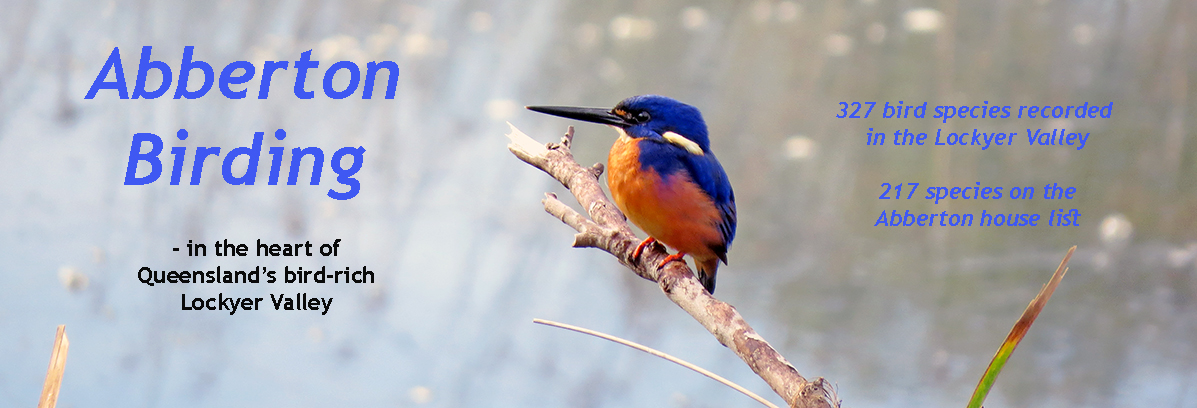GO DIRECT TO LATEST POSTING
February / March, 2016

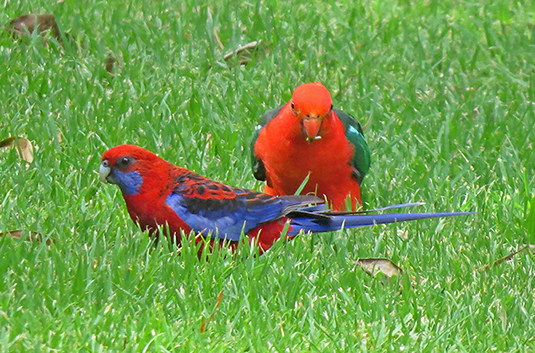
Two Australian King Parrots - and one with a Crimson Rosella
I was hoping for a good day out on Tuesday with a couple of visiting birders from UK, but first, we had to get on the road, which can be difficult when there's a lot buzzing around in the garden. It can take me an hour or so to check the mail up at the gate some days, though if it's raining I can do it in under five minutes!
We'd already had a couple of good days, bird list building nicely, and had just talked about our possible targets for the day when I popped indoors to pick up my phone before the off - only to find on my return to the verandah my two highly excited visitors with binoculars glued onto a platypus feeding in the creek right in front of the house.
What a privilege it is to watch a platypus seeking around systematically, making frequent otter-like rolling dives to search the creek bed, while we look for clues, be they eddies or bubbles, to indicate where it will surface next. A great start, and surely the highlight for the day, before we start out.
I had planned amongst other things to check out the sometime Sooty Owl roost in the Bunya Mountains, where I used to see them on and off back in the 1980s & 90s.
Then, after a long spell with no sightings for a few years, just occasional sightings again, and over the last couple of years fairly regular once more. When we did eventually reach the target roost-tree in the Bunyas, after many stops along the way, I naturally talked down any possibility of a Sooty Owl being in residence, and pointed out that the average success rate over several decades was very low.
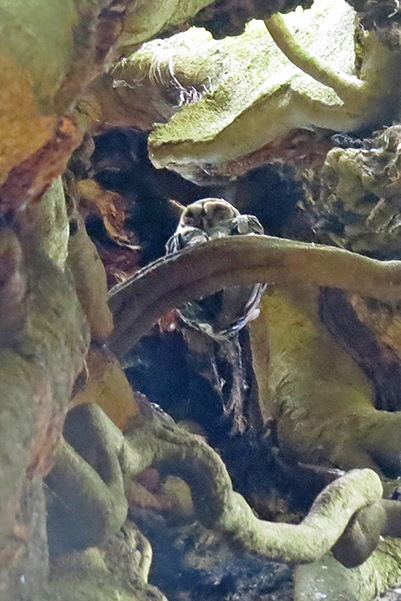
Sooty Owl at its roost high in a hollow tree
But the Sooty Owl was there! Bird of the day of course, but maybe not sighting of the day after the unexpected platypus.
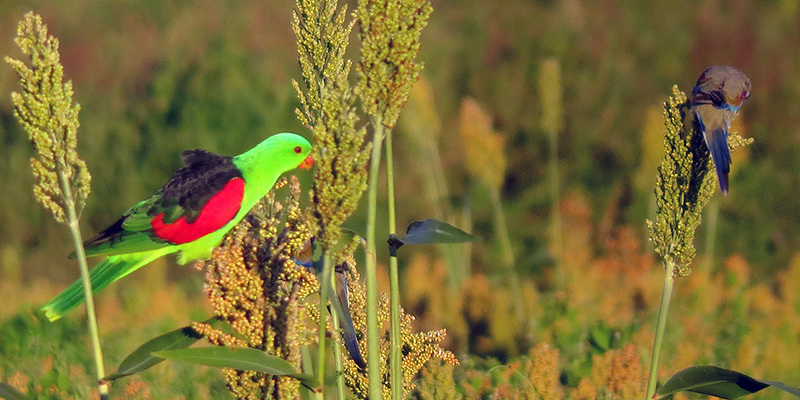
Red-winged Parrot and Bluebonnet
We had another pleasing surprise on the way home, when we stopped to look at some brilliant Red-winged Parrots feasting in a sea of sorghum,
only to find once the binoculars were on them, that they had several diminutive and much less brightly coloured Bluebonnets feeding alongside.
Bluebonnets can be tough little parrots to find, and even tougher to get a close look at.
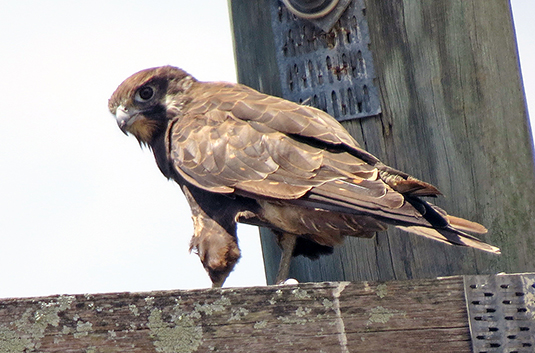

Two different Brown Falcons, seen on consecutive days
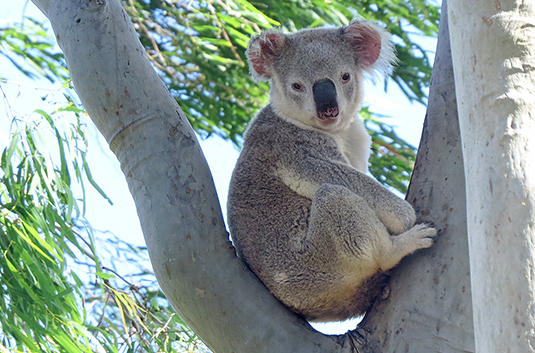
A long-term Abberton resident...
25 March, 2016 - An owl, a falcon and a parrot
It sounds like the start of an Aesop fable! But these three don't know each other. The common denominator is simply that each allowed me to photograph them over the last week or so.
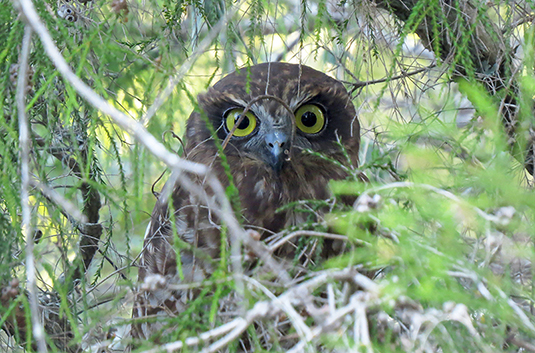
Southern Boobook in the garden
The Southern Boobook was in our garden, minding his (or her) own business, not quite hidden in a tree.
It was the persistent harassment from a White-throated Honeyeater that gave the owl away.
I managed just one quick snap, then retired speedily, hoping that he (or she) will stay around for a while.

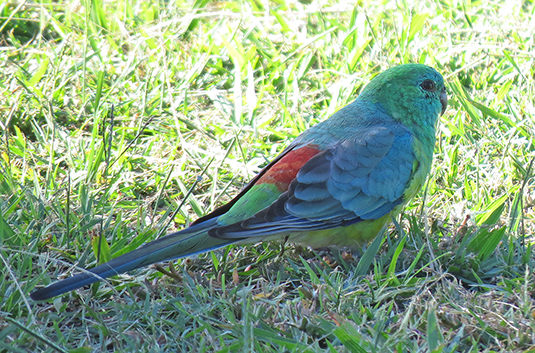


The Nankeen Kestrel pic is of a bird on a wire, which the purists might not like, but given that I'm a birder first and a photographer a long way second I really must share her with you - a lovely female kestrel!
I find it difficult to get a good snap of a Red-rumped Parrot. To start with they are small and mostly green, and usually feeding in the grass! And on hot days (most days) they prefer to feed in the shade, if there is any to be found, and then so often just inside the edge of a sharply delineated line of shadow from a tree with the full glare of the sun beating down on the grass just centimetres away - all of which plays havoc with camera settings -in so far as I understand them! But this time, I was able to sneak close enough in the car to share their shade and I captured the attached photo of a male bird, with his red 'rump' well on display.

Eastern Yellow Robin
June, 2016 - An influx of waterbirds
Lockyer Creek in front of our house is currently teeming with water-life and is attracting an influx of feeding waterbirds.
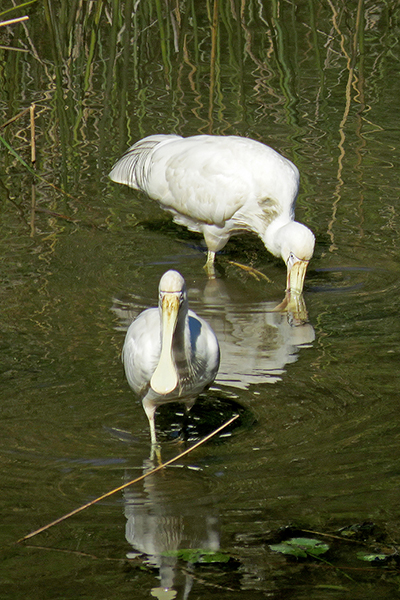
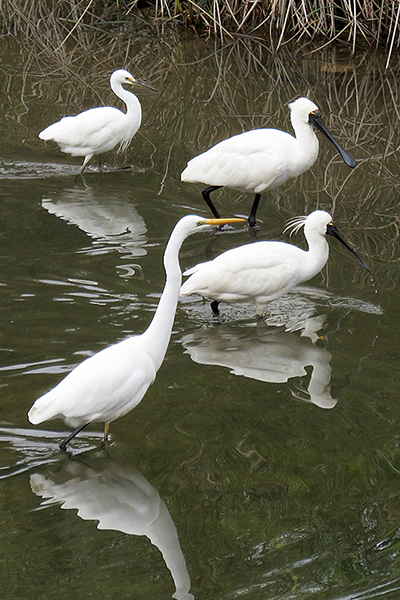


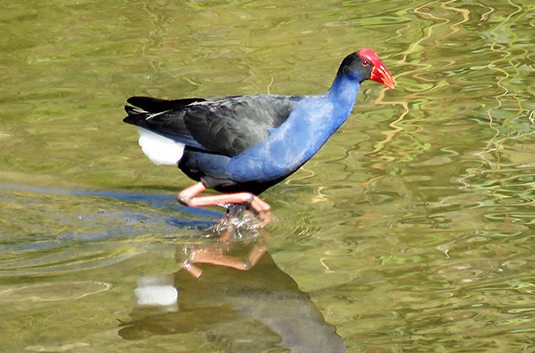
One of our resident Purple Swamphens
July/August 2016
Firstly, some of the more inland species we saw out around the Traprock area near Gore early in the month - all three of these birds photographed in the one paddock by the way.
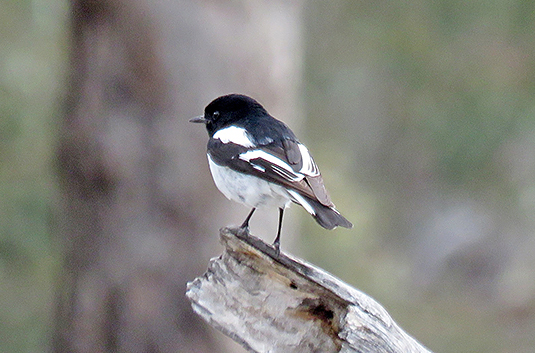



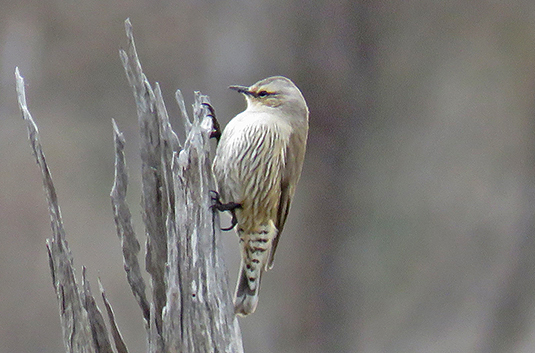
Brown Treecreeper
... and two species that have been regular at Abberton of late.
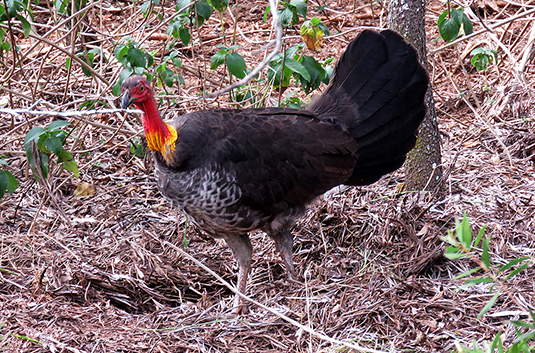
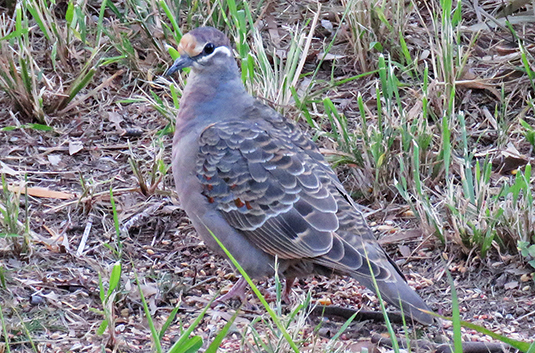


30 August 2016 - and a new bird for Abberton!
Today we were overtaken by a great morning's birding at Abberton. It's been particularly good over the last few days in fact, it's really an early spring - hordes of Fairy Martins overhead every day, with Rainbow Bee-eaters soaring and calling above and below them. Azure Kingfisher regular along the creek, platypus feeding in front of the house on Saturday, Spotted Pardalotes and Scarlet Honeyeaters in the tall gums close to the house, in fact 98 species around the garden during this month so far - until this morning that is.
This morning, Eileen experienced the amazing sight of a Black-necked Stork flying high over the house, describing wide circles as it climbed higher and higher in a generally westerly direction.
No time for a photograph alas, the whole thing was over in just a couple of minutes. As Eileen called to me, I was fumbling for binoculars and camera and managed to miss the whole thing! Breathtaking, amazing, species number 99 for the month, and bringing the house list to 220! Well, breathtaking for Eileen, I was just out of breath with no reward other than her delight!
And below - a couple more regulars from the garden.

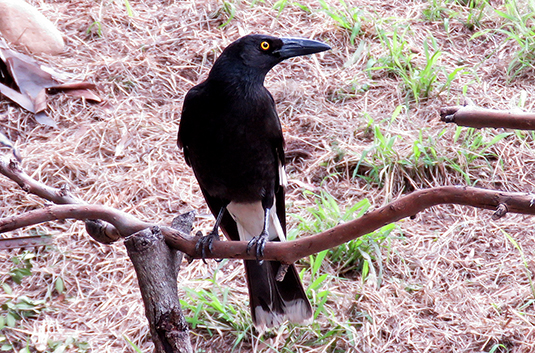


November 2016 - Spotless Crakes, Bluebonnet, Dollarbird

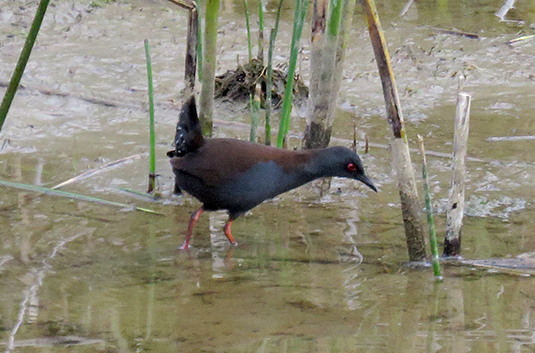
Spotless Crake
In recent days we have had great views from the verandah of 2 adult Spotless Crakes together with 2 very active chicks. The first time we recorded a Spotless Crake here was on 7th October 1989, while scanning from the creekbank. Then, nothing for 27 years and 1 day, until on 8th October this year, in the late-afternoon, we spotted one bird on a narrow strand of mud on the opposite side of the creek, directly in front of the house.
Now, after having been away for a few weeks, we've returned in November to find the creek is a lot lower, the mud is a lot wider, and we have a family of Spotless Crakes!
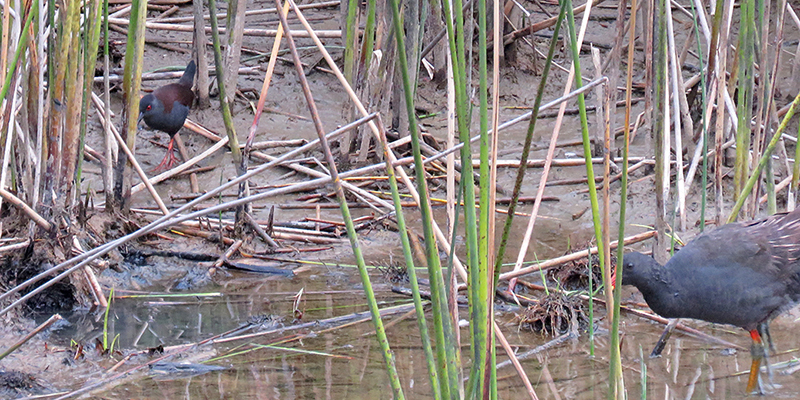
This Spotless Crake photo, with a Dusky Moorhen in view, emphasises just how small these crakes are.
Just now we're experiencing a hot and dry spell here, and despite having seen parents and chicks on consecutive days, (3rd and 4th November) we haven't had a sighting since.
Anyway, twice in 27 years amounts to positive reinforcement in my book, so I'll keep expecting them back!
I took a visitor up to the Bunya Mountains last week, and had a good bird-filled day - saw all we expected, along with a few bonus birds, and memorably an unexpected sighting of a Bluebonnet bathing in a roadside puddle.
Not the sharpest photos alas, but what a spectacular little parrot! And a snap of a Dollarbird, for the same reason as the Bluebonnet, too lovely not to be photographed..

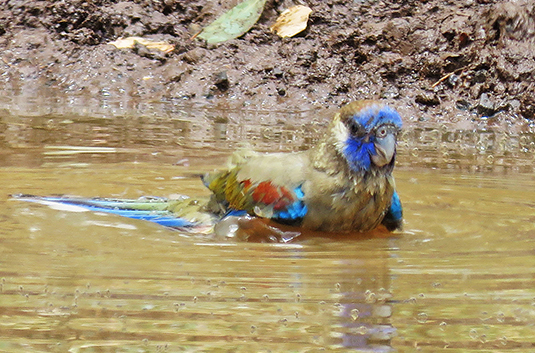
Bluebonnet bathing
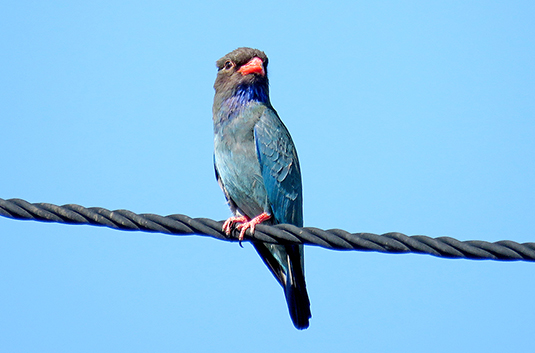
Dollarbird
A busy November
November continued hot and dry, but the birds kept coming.
Michael Wood spent the day here on 17th November, and observed more than 70 spp before lunch. I joined him for a late afternoon walk around the place and together we brought the day's tally to 82,
which now stands as the highest species count for one day's birding around the garden at Abberton.
Given that we were in the middle of a hot spell with the creek low and many waterbirds absent, I think we might well challenge it next October or November.
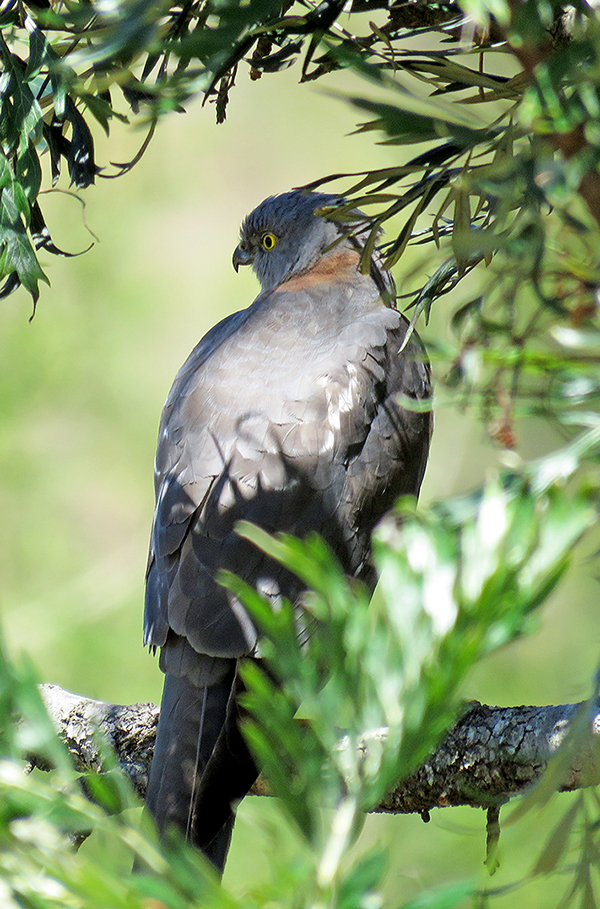
Collared Sparrowhawk
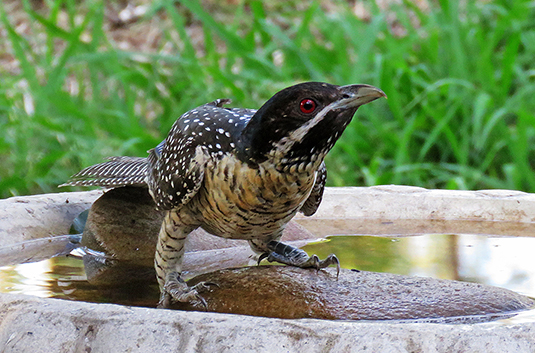



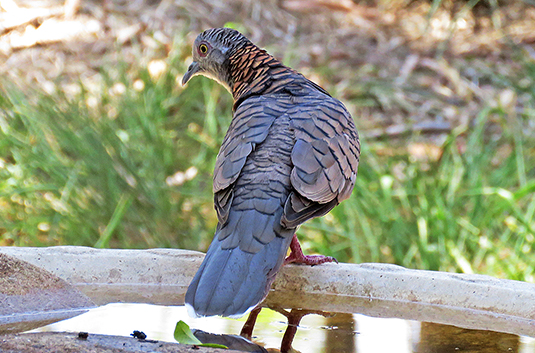
Bar-shouldered Dove
It continues hot and dry, though with some welcome storm rain in the late afternoons.
Accordingly, the bird bath outside my window has had non-stop traffic over the last couple of weeks.
Update on the Spotless Crakes - and a Pale-vented Bush-hen
The Spotless Crakes proved to have three chicks, not just the two first deduced, and they have been seen most days through the month, and surprisingly at all hours of the day - not just in the late afternoon as we erroneously expected. Perhaps they are not so much crepuscular as furtive. We were lucky that they nested right in front of the verandah, so we've seen a lot of them.
Just after dusk on 30th November, a Pale-vented Bush-hen was calling loudly and persistently from this same reed-bed. Our first record of Bush-hens in the Lockyer Valley was from the same spot in 2003, and they returned here for six successive years, breeding on several occasions. Then a re-appearance in 2013, and now again this year. Fingers crossed they stay longer and breed again!
December 2016
The window next to my desk happens to open outwards, so I have to photograph through the glass. I've thought long and hard about ways of putting something like a weatherproof cat-flap in there at desk height,
which I could open inwards for an uninterrupted view out, but I understand that could meet with some opposition on aesthetic grounds!
So for the time being I'll continue photographing these birds close to the house through the glass.
Meanwhile, here are some more from the desk to round off 2016.
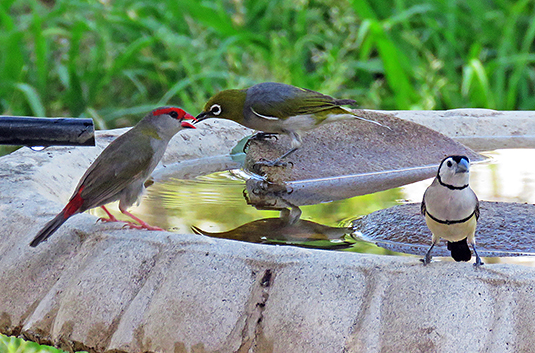
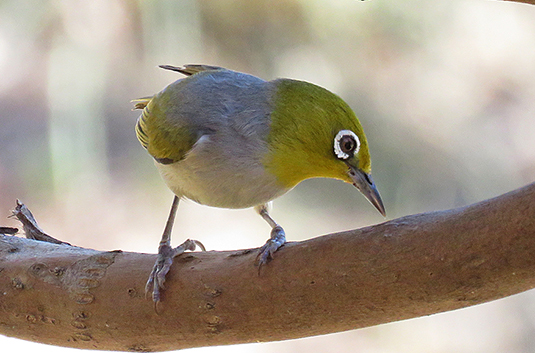


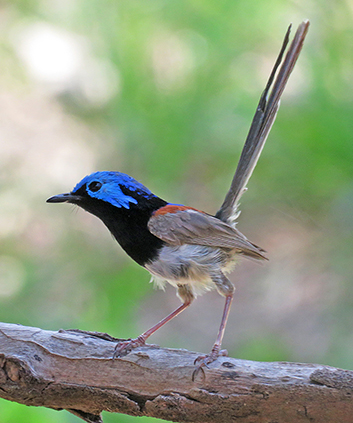
Variegated Fairywren
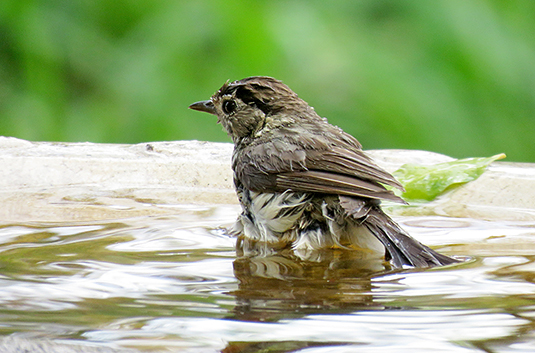
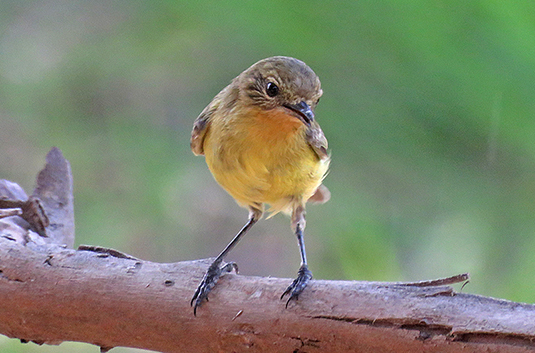


January/February 2017
We experienced a hot start to the year, and the birdbaths were in constant use, sometimes as many as six or seven species at a time competing for space in or near the water - which we were topping up several times a day.
So we'll kick things off for 2017 with a collection of birds photographed at the birdbath just outside my study.
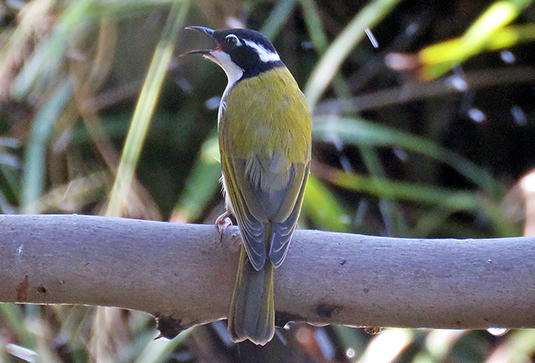
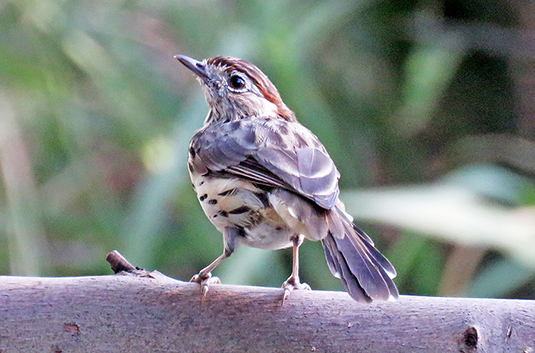


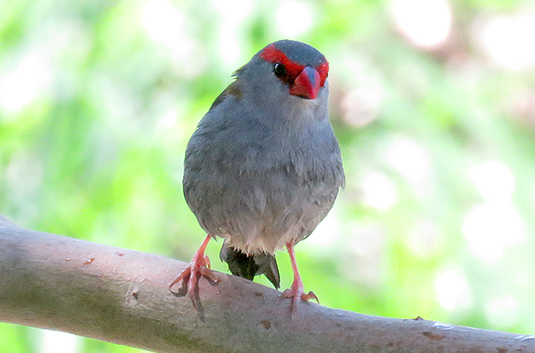
Red-browed Finch
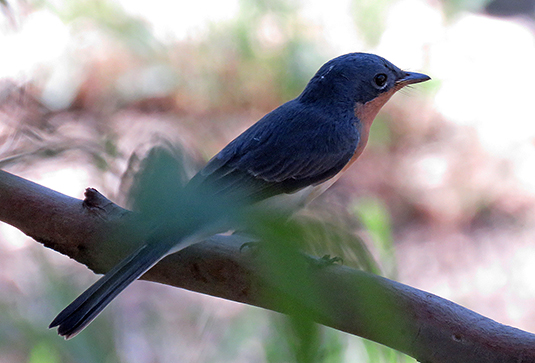
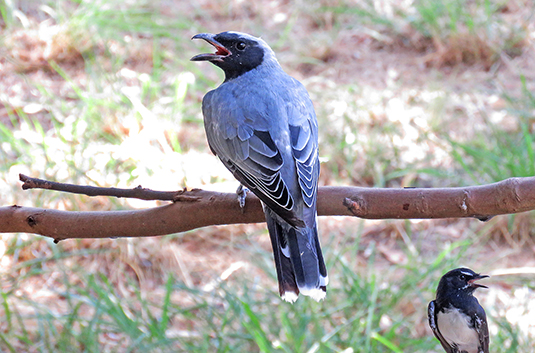


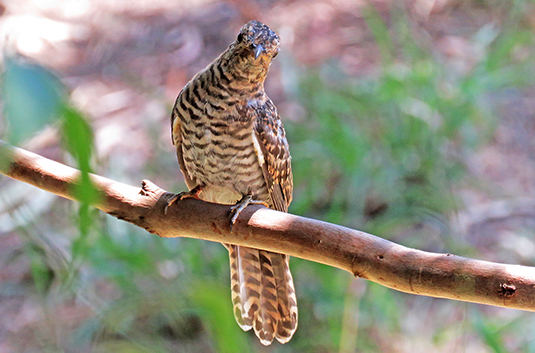
Brush Cuckoo (immature)
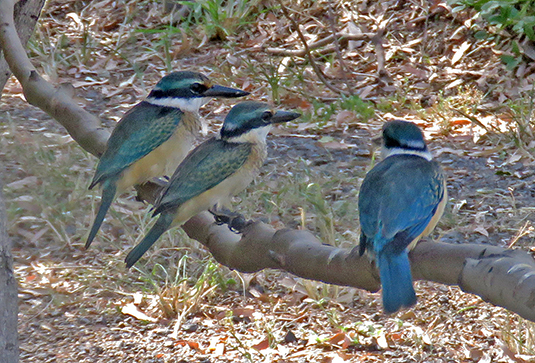
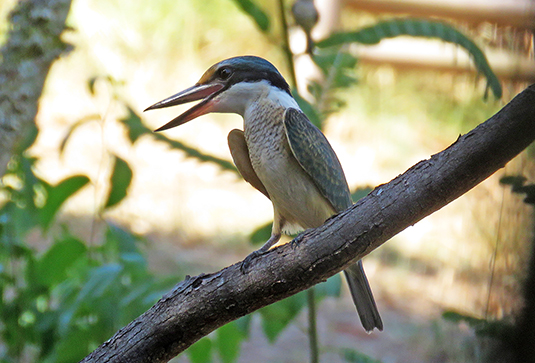


Some images from Autumn - March to May 2017
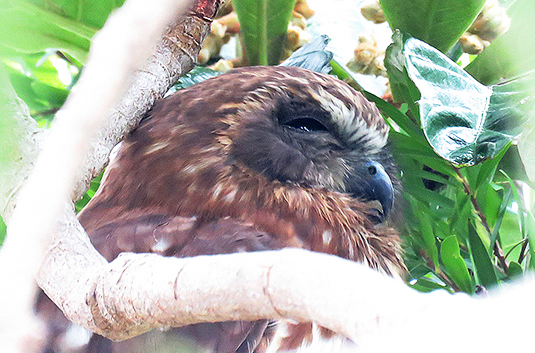
A Southern Boobook trying to get some shut-eye in a friend's garden




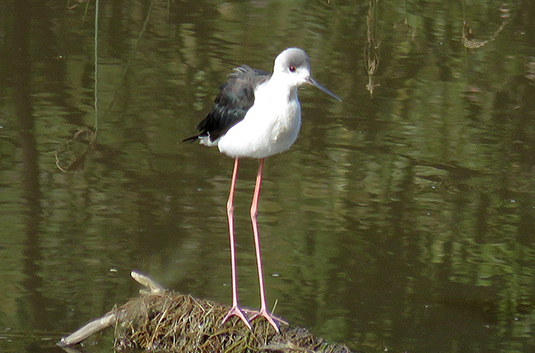
Black-winged Stilt (immature)
The creek is always changing and our smallish reed-bed in front of the house is showing the potential of developing into something more extensive, though still with a tempting patch of shallow open water
right in front of the house (for which read verandah). Black-winged Stilts are at best very occasional visitors to our place, so we were delighted when this youngster dropped in in May.
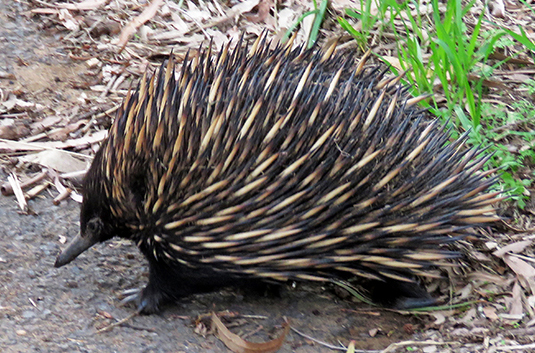
Short-beaked Echidna
Echidnas on the other hand are always about somewhere, either shuffling along or digging furiously into an ant nest or termite mound.
This one wandered across my path with typical rolling drunken-sailor gait, seemingly unconcerned that I was close by.




These Wedge-tailed Eagles were overhead at Abberton. The Wompoo Fruit-dove however was in our nearest rain-forest 27km away at the end of Seventeen Mile Road. (Well, that's my conversion...)
The following two photos were taken by my good birding friend Michael Wood when he was here in late May.
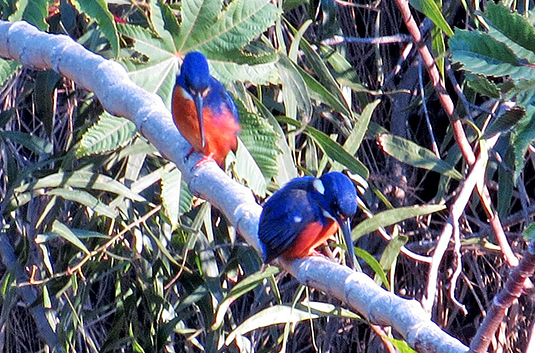
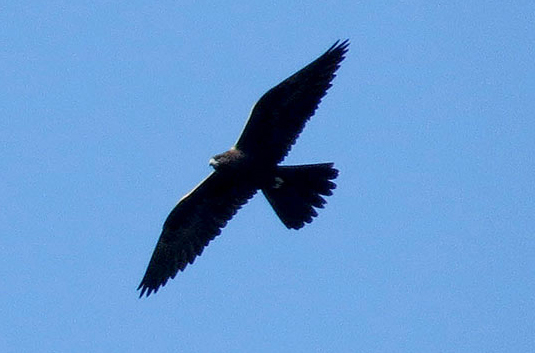


A great shot of two highly interactive Azure Kingfishers on a creekside branch just across from the house, and something I find very difficult to obtain - a photo of an overhead Black Falcon.
One of the most dramatic aerobatic sights I've ever seen was a Black Falcon in pursuit of a Hobby, hassling it to drop its newly caught prey.
I fired off dozens of shots at those fast moving targets - without success. Congratulations to Michael on capturing this Black Falcon in flight over Abberton, and thanks for the pics.
June 2017 - A change of guard
Two Rose Robins are around the garden today, including this one, fresh from the birdbath
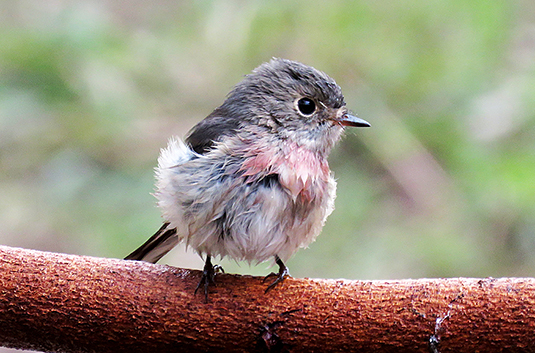
Rose Robin
Meanwhile, all the regulars remain busy. Here are a couple of fairly distant shots of an Azure Kingfisher spotted from the verandah during breakfast the other day, and an Australian Hobby in a dead tree just across the creek.
And if you've ever wondered why the Spangled Drongo is so called - the two photos below of the same bird surely go some way to explaining it!

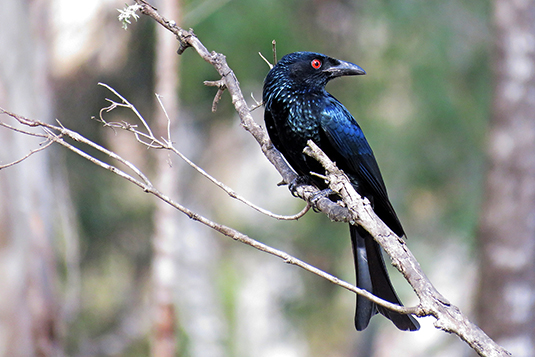
Spangled Drongo
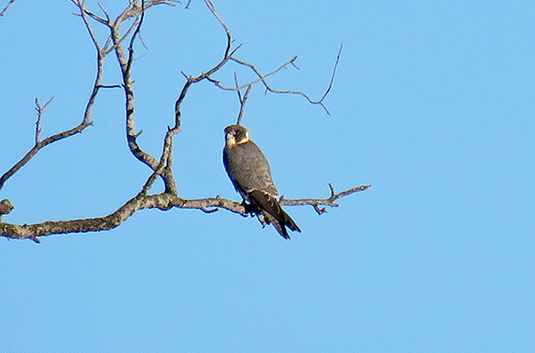
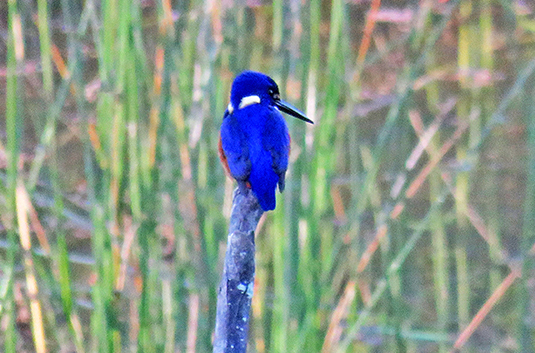


<
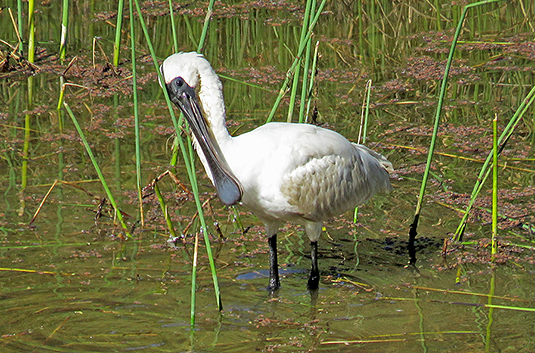
This Royal Spoonbill spent the day feeding in the creek


An immature Pallid Cuckoo in a tree across the creek, and a Fan-tailed Cuckoo on a powerline near our gate
Birding for five days in June with Ken & Sarah Harris, visiting from Idaho, yielded 135 spp around the traps.
We met Pallid Cuckoos in several locations, as well as Shining and Horsfield's Bronze Cuckoos and both Fan-tailed and Brush Cuckoos.
The highlight however was courtesy of birding friends who had been monitoring a nesting pair of Powerful Owls for some time and kindly took us along to see them.
Many thanks Kev and Kay!
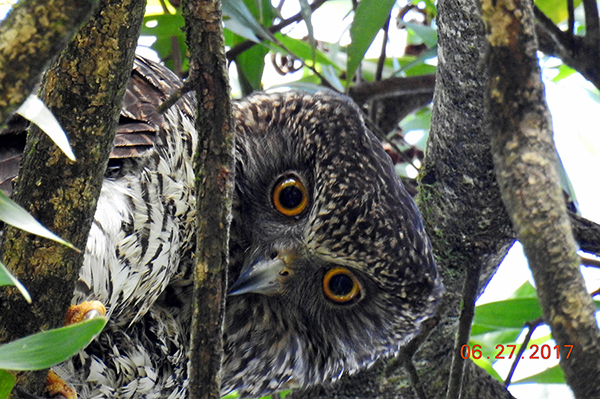
Powerful Owl
(Photo: Ken Harris)
I took some photos of course, but none of them compared to this one of Ken's!
At the same location I was very pleased to get this close-up of one of the most beautiful little birds in the Australian bush -
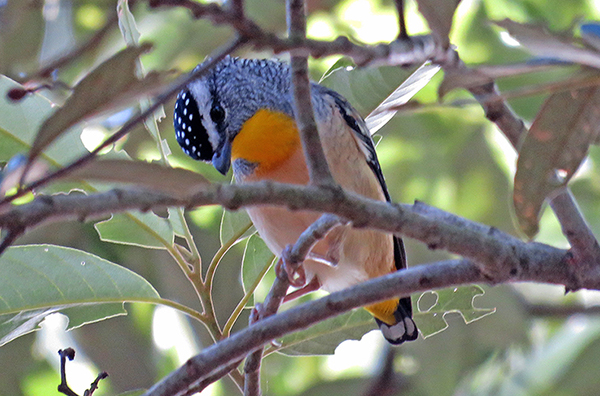
Spotted Pardalote
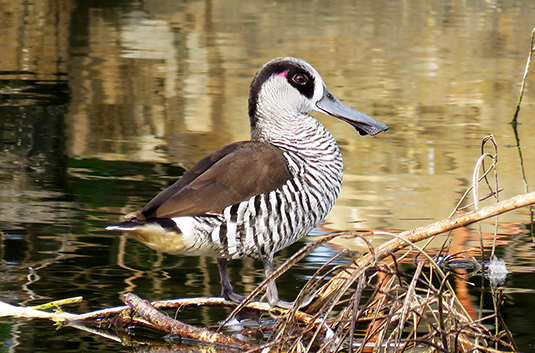
A Pink-eared Duck at a local lagoon obligingly showing off its often hard-to-see trade-mark feature


A Horsfields Bronze Cuckoo feeding on the ground in the rain and a group of Yellow-tufted Honeyeaters at an inland waterhole.
July 2017
In early July, the few species we temporarily lose from Abberton for winter were compensated for by an upsurge in raptors (11 raptor spp in the first week), as well as a good mix of cuckoos, and winter visitors such as Little Eagle.




Cuckoo and raptor activity continues throughout these sunny winter months. Little Eagle, White-bellied Sea-eagles and Swamp Harrier all here the other day, along with regular kites, hobby and goshawks.
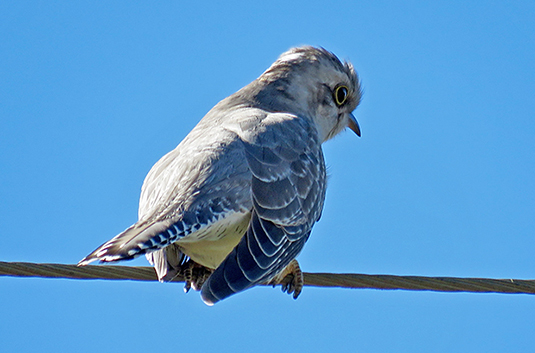
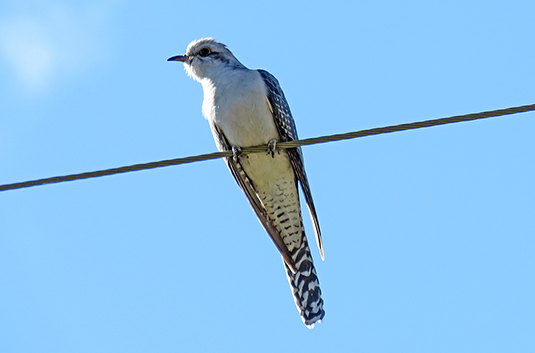
A drop-in Pallid Cuckoo photographed from two different angles

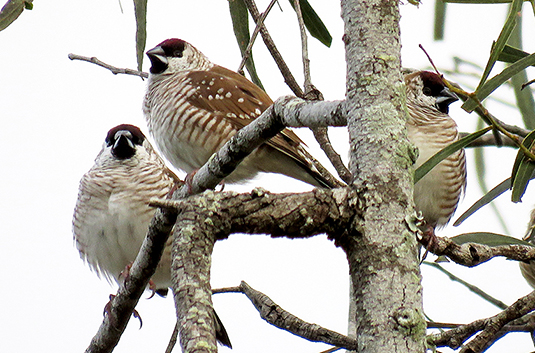
A Plum-headed Finch mixing it with some Double-barred Finches in our top garden, while his mates hang out in a nearby tree.
July/August, 2017 - A melange of fairy-wrens!
It's a veritable blaze of fairywrens around the garden just now!
All three of our resident species are everywhere, in numbers and showing off non-stop!
I hope these three pics will give an indication of the daily kaleidoscope around us.
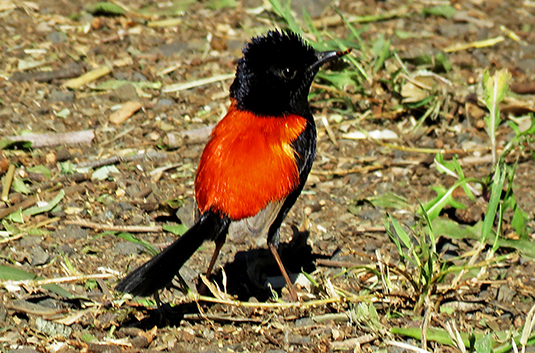
Red-backed Fairy Wren displaying

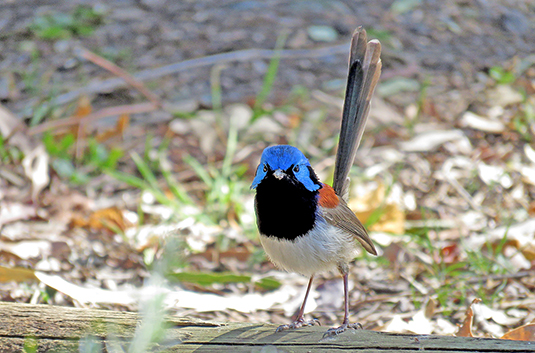


Red-backed Fairywren - Sometimes ten or so chasing each other around in front of the house the other morning - at least six stunningly coloured adult males. So much performance and interaction, it really was like watching a lek!
Variegated Fairywren - For me the most stunning of all the fairywrens. This male looks almost too good to be true, but I really haven't fiddled around with colours or sharpness. This is just how magnificent these birds are right now.
Superb Fairywren - He doesn't have the gaudy colours as the other two spp in the garden, but he is indeed superb. At present, we regularly see male fairywrens carrying petals as part of their display. In my experience, it's always a yellow offering from a male Superb, always a red one from a Red-backed or Variegated.
Now some other garden regulars:
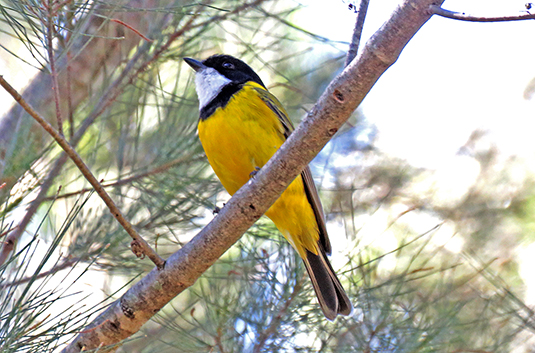
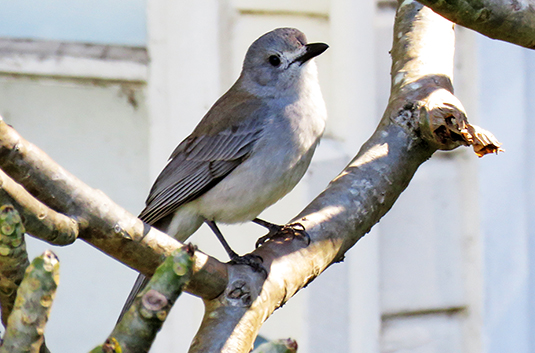



This Red-necked Wallaby clearly has a taste for unkempt grass.
Yet another reason not to work too hard in the garden....
Elsewhere in the Lockyer Valley, on the same day-
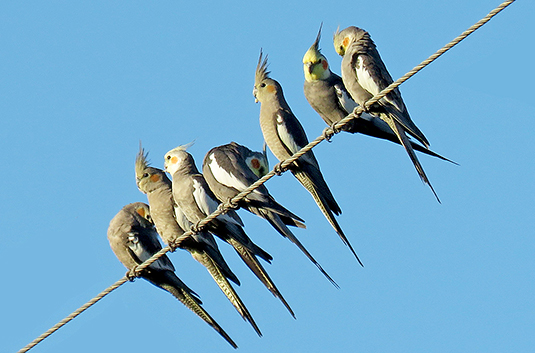



Our now regular Black Swans have nested for the third time in less than eighteen months in the same location, within view of the house.
Their first nesting yielded only one hatchling from four eggs. The second time they succesfully raised four cygnets.
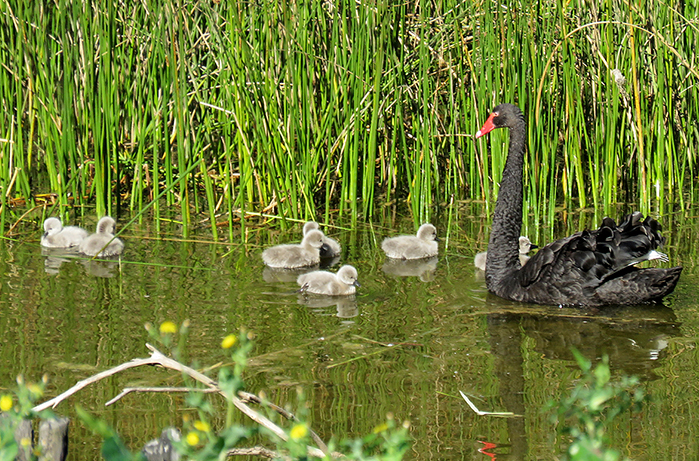
Our resident breeding Black Swans have done it again!
But this time there are seven cygnets!
More of August 2017 - Our Spring-like Winter continues
Well, heaps of birds, it's more like spring than late winter. Nesting activity everywhere.

Olive-backed Oriole
I snapped this breeding-plumage Olive-backed Oriole from my desk, ie in the shade of the house, while the birdbath was in half-shade, and beyond it was full sunlight. So while I was lucky to catch the colours and detail of the bird, everything beyond is just a wipe-out of glare. Still, it shows just how gorgeous these orioles are. They nest here every year.
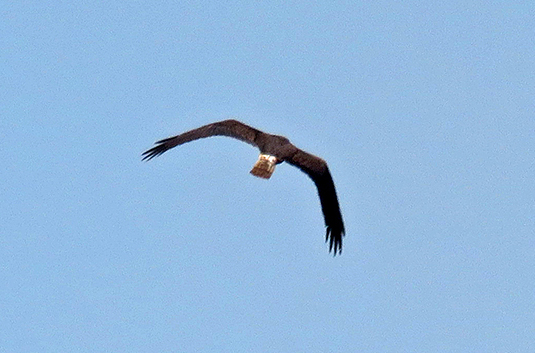

We've been getting occasional visits from this Swamp Harrier of late - which really upsets the creek-side residents. Over the years Spotted Harriers have been the more regular of the two harriers here, routinely and systematically quartering both sides of the creek. By comparison this Swamp Harrier sweeps in briefly from time to time like a marauder, causing chaos beneath his flight path.
Incidentally, apart from the obvious differences of plumage, this individual is also a heavier, bulkier bird than our more regular Spotted Harriers.




We came across the Tawny Frogmouth just alongside the driveway as we arrived home late from town one evening. They're usually somewhere around the place all year, and nest here in a long-favoured eucalypt every September/October, with two or three young emerging in late October/November.
The Bar-shouldered Dove is a real favourite of mine. I think it is one of the most 'quietly beautiful' birds we have here. Well it works for me, and I've definitely got a soft spot for them.
There only two other Geopelia doves in Australia, the Peaceful Dove and Diamond Dove, both lovely birds.
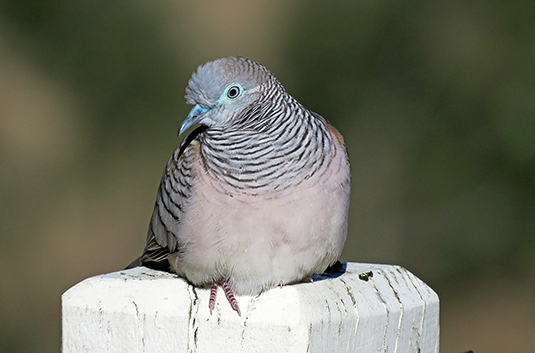
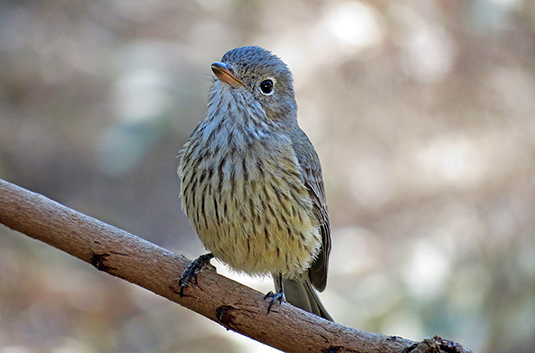


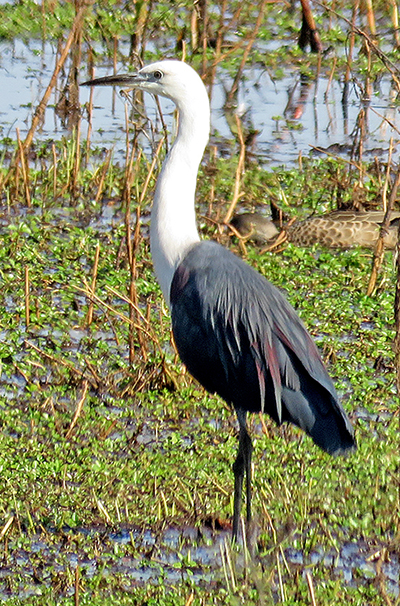
White-necked Heron at a local pond.
September 2017 - Now it really is Spring!
And it's all happening!
We were mightily excited last November when we realised that we had Spotless Crakes breeding here - 27 years after our only previous Abberton sighting.
Accordingly, there was double excitement during breakfast on the verandah the other day when we again saw a Spotless Crake poking around in the shallows right in front of the house!
And the next morning there it was again, darting around in the same area where they nested last year.
However, double-excitement magnified to treble shortly after when, thinking I had spotted it in the exact same spot once more, I said to Eileen "He's out again" as I raised the binoculars
- only to find that I was looking at a Baillon's Crake!
Two different crakes out in front of the same patch of sedge within minutes - and probably both inside it at the same time throughout.
The Baillon's took a wander downstream along the opposite margin, and I made my way down a little closer to try for a photo,
following which, as I came back along the creek towards the house, I encountered the Spotless, and snapped it too.




...and the next day in the same spot...
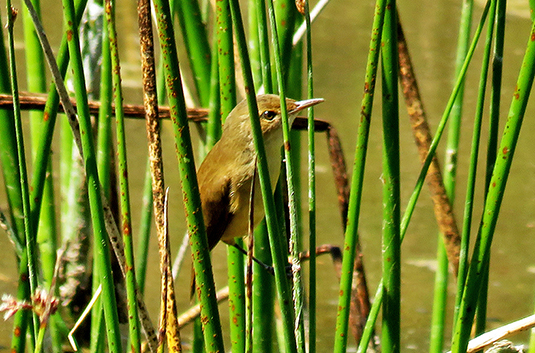
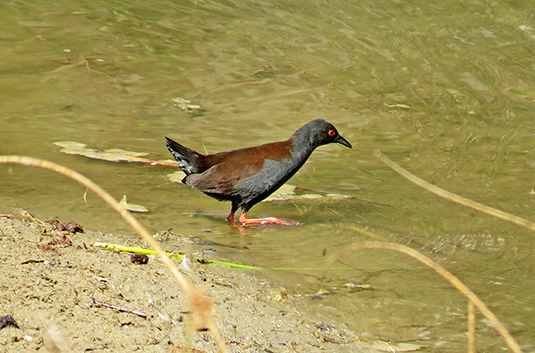


Meanwhile, a few birds from nearby:
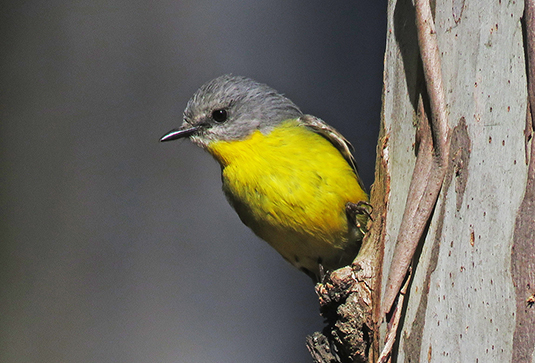
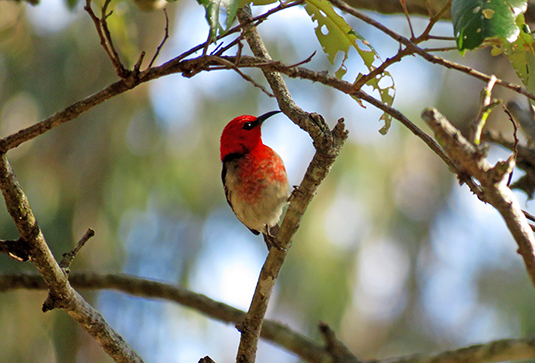



Fan-tailed Cuckoo
And some from further afield in the valley:
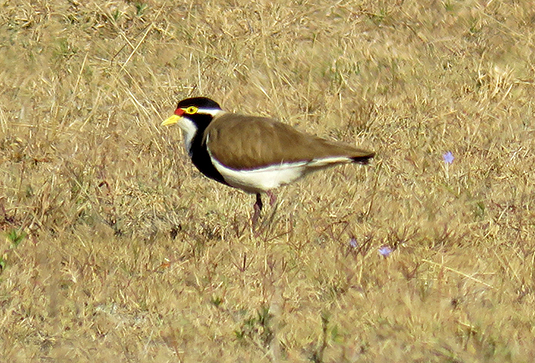
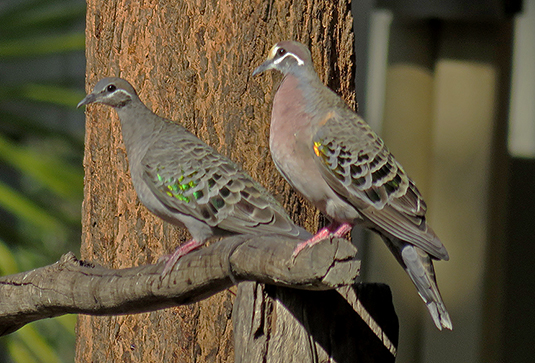



White-winged Choughs
